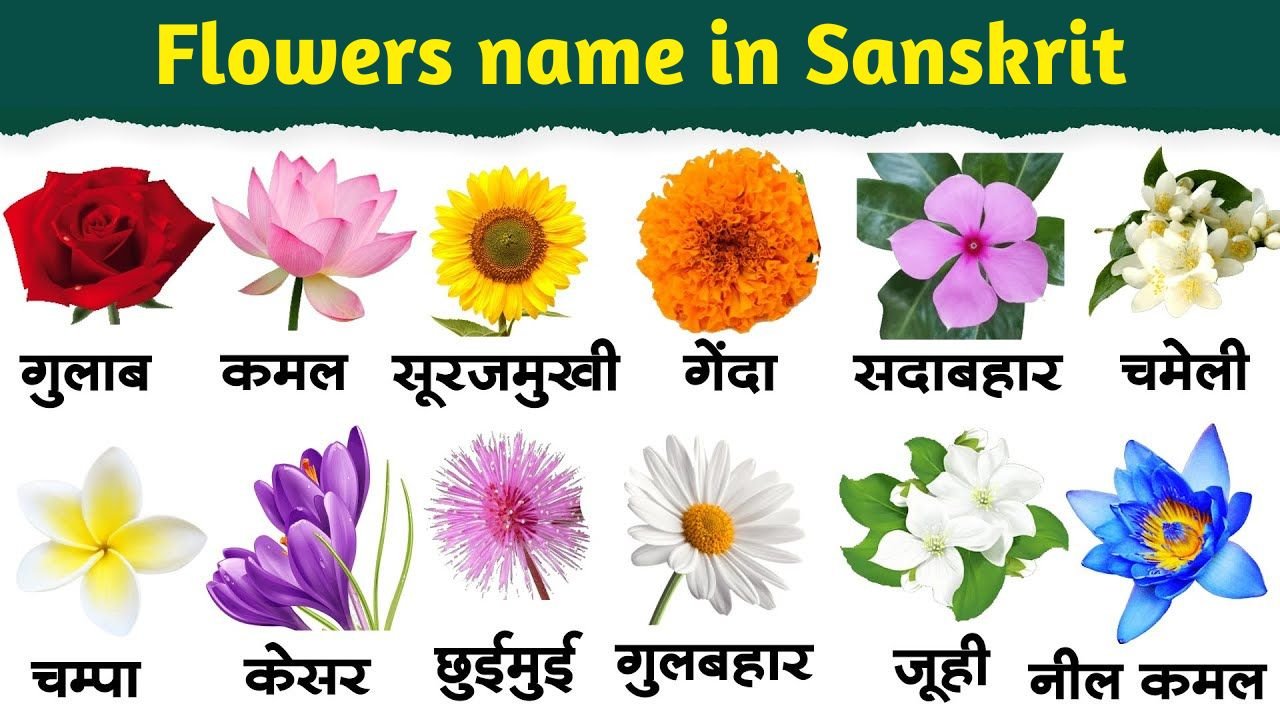Flowers have always played a vital role in human culture, symbolizing beauty, spirituality, and emotions across different civilizations. In India, the ancient language of Sanskrit has a rich tradition of naming flowers, each name reflecting not only the flower’s appearance but also its deeper cultural and spiritual significance. Understanding these Sanskrit names can offer a new perspective on the timeless connection between nature and human language.
This article takes you on a journey through the names of flowers in Sanskrit, highlighting their beauty and importance in Hindu mythology, literature, and everyday rituals.
Why Are Flowers Name in Sanskrit Important?
Popular Flower Names in Sanskrit and Their Meanings
Let’s explore some common flowers and their names in Sanskrit. These names are not only beautiful to hear but also carry significant meanings that reflect the qualities or the spiritual symbolism associated with the flowers.
Lotus (पद्म – Padma)
One of the most revered flowers in Indian culture, the lotus (Padma) symbolizes purity, enlightenment, and rebirth. In Hinduism, people associate jasmine with gods like Vishnu and Lakshmi, who are often depicted sitting on a lotus flower.
The lotus beautifully rises from muddy waters, which is why people consider it a symbol of spiritual awakening and purity.
Jasmine (मल्लिका – Mallikā)
Rose (पाटल – Pāṭala)
Sunflower (सूर्यमुखी – Sūryamukhī)
Sanskrit refers to the sunflower as Sūryamukhī, which literally translates to “the one with the face of the sun.” This flower symbolizes loyalty, faith, and longevity.
Hibiscus (जपापुष्प – Japāpuṣpa)
Marigold (हरिद्र – Haridra)
Tulip (कन्द पुष्प – Kanda Puṣpa)
Frangipani (कर्णपूर – Karṇapūra)
Night-blooming Jasmine (रजनीगन्धा – Rajanīgandhā)
Known as Rajanīgandhā, which means “fragrance of the night” in Sanskrit, the night-blooming jasmine is famous for its heady perfume that becomes strongest after dusk. People often use this flower in spiritual practices and associate it with the moon and femininity in Indian culture.
Champak (चम्पक – Champaka)
The Champak tree produces highly fragrant flowers that have a deep significance in Hinduism and Buddhism. Known as Champaka in Sanskrit, people use these flowers in religious rituals, and their yellow or white blooms symbolize beauty, devotion, and simplicity.
Flowers Name in Sanskrit and Their Symbolism in Hindu Rituals
In Hindu rituals, flowers play an indispensable role. Each flower associates with specific gods and attracts positive energy, depending on the type of ritual performed.
Understanding the Sanskrit names of flowers and their symbolism can enhance one’s spiritual practice.
- Lotus (Padma): Represents the highest level of consciousness, often used in offerings to Goddess Lakshmi and Lord Vishnu.
- Jasmine (Mallikā): Symbolizes purity and is used in devotional offerings, especially to Lord Shiva.
- Hibiscus (Japāpuṣpa): Commonly offered to Goddess Kali and Lord Ganesha, symbolizing power and protection.
- Marigold (Haridra): Considered an auspicious flower, used in garlands for deities and to decorate temples during festivals.
The Role of Flowers in Ayurveda
The Sanskrit names of flowers also carry insights into their medicinal uses:
- Rose (Pāṭala): Used in Ayurvedic formulations for skin health, emotional balance, and cooling the body.
- Lotus (Padma):
- Jasmine (Mallikā): Believed to have properties that balance the body’s doshas (life energies) and improve mood.
Cultural and Poetic Significance of Flowers Name in Sanskrit Literature
In ancient texts, the imagery of flowers like the Champak and Rose evokes a sense of divine beauty, emphasizing the interconnectedness of nature and spirituality.
Conclusion
Flowers in Sanskrit not only carry beauty in their names but also symbolize deeper meanings connected to spirituality, nature, and culture. By learning the names of flowers in Sanskrit, we gain a unique insight into the profound relationship between nature and the ancient Indian way of life. Whether you’re exploring these names for educational purposes or to deepen your spiritual practice, the ancient language of Sanskrit continues to enrich our understanding of the world around us.
FAQs
What is the Sanskrit name for lotus?
The Sanskrit name for lotus is Padma. It symbolizes purity and spiritual enlightenment, and people often associate it with deities like Vishnu and Lakshmi.
Which flower is known as Mallikā in Sanskrit?
What is the significance of flowers in Hindu rituals?
In Hindu rituals, people consider flowers auspicious and offer them to gods and goddesses as a symbol of devotion and respect. Each flower has specific symbolism, such as purity, strength, or beauty.
What is the Sanskrit name for rose?
The Sanskrit name for rose is Pāṭala. It represents love, devotion, and passion in Indian culture.
How are flowers used in Ayurveda?
Which flower is called Sūryamukhī in Sanskrit?
Sūryamukhī is the Sanskrit name for sunflower, symbolizing strength, loyalty, and vitality.











